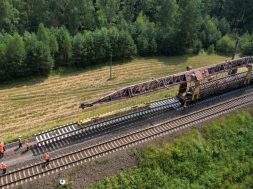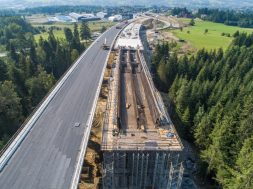The Road Forward
The Road Forward
Keeping pace with the industrial development and rapid socio-economic development, the roads sector in India has immense potential to grow. ACE Update highlights the opportunities, roadblocks and road ahead
India has the second largest road network in the world with a total length of 46.90 lakh km. Roads are the major mode of transportation in India as they carry almost 85 per cent of the country’s passenger traffic and about 60 per cent of its freight. Therefore, roads play a crucial role when it comes to overall socio-economic development of an economy. In an aim to empower rural India by providing required road connectivity, the government has announced a renewed thrust to rural India during budget 2013-14. The allocation to rural development made higher by nearly 50 per cent with a focus on improving road infrastructure. According to the industry estimates, the value of total roads and bridges infrastructure in India is expected to grow at a CAGR of 17.4 per cent over FY12-17 to reach $ 19 billion.
Road development programme in India In 2009, Goldman Sachs estimated that India will need to invest $ 1.7 trillion on infrastructure projects before 2020 to meet its economic needs, a part of which would be in upgrading India’s road network.
During the 12th Five Year Plan (2012-17), the government’s estimated investment target for central sector roads and transport is Rs.3,97,598 crore, which includes gross budgetary support (GBS) of Rs. 1,44,769 crore, internal and extra budgetary resources (IEBR) of Rs. 64,834 crore and private sector investment of Rs. 1,87,995 crore.
In 2013-14, the Ministry of Road Transport and Highways (MORTH) plans to improve about 8,270 km of the national highways along with construction and rehabilitation of almost 100 bridges and four bypasses as standalone projects at an estimated cost of Rs.23,300 crore.
To attract private investment for the development of road sector, the government has been providing capital grant of 40 per cent of the project cost to enhance viability and 100 per cent tax exemption in any consecutive 10 years out of 20 years. Entrepreneurs are also allowed to collect and keep the amounts from tolls on build, operate and transfer (BOT) projects.
Scheme
Physical target
Widening to 2-lane (km)
14,800
Widening to 4-lane (km)
9,826
Widening to 6-lane (km)
5,590
Strengthening / improvement of riding quality programme (IRQP) (km)
8,500
Construction of bridges (No.)
50
Construction of bypasses (No.)
5
(Source: Ministry of Road Transport & Highways)
Investment opportunitiesIn order to promote private sector and foreign investment in the roads sector the government has implemented various policy initiatives. With the government allowing 100 per cent FDI in the roads sector, many foreign investors have formed consortiums with Indian companies to participate in the development of road projects in India. Today, construction companies are awarded with large order books and portfolios of BOT projects. Also, to maintain the liquidity flow, the government announced provision of subsidy up to 40 per cent of project cost to make projects viable on a case-to-case basis, 100 per cent tax exemption in any consecutive 10 years out of 20 years after commissioning of the project, duty free import of high capacity and modern road construction equipment etc. Projects related to highway-widening qualify for the 10-year tax break under Section 80 IA of the Income Tax (IT) Act.
World Bank’s assistanceThe World Bank has decided to provide a $61.7 million to support the Himachal Pradesh government in strengthening its road network.
The original $220 million Himachal Pradesh State Roads Project, which became effective on October 5, 2007, was aimed at reducing transport costs and improving traffic flows on priority segments of the core road network of Himachal Pradesh. The project includes widening and strengthening of about 447 km of existing state highways to two lane roads, undertaking periodic maintenance of about 2000 km of core road network, and strengthening institutions to help manage the road network.
The additional funding of $61.7 million will help the Himachal State Roads Project fulfil its original objective. The project is also experiencing cost overruns. According to the World Bank, the additional financing will support the state meet increased costs of upgrading roads including bio-engineering works, resettlement and rehabilitation work, and additional institutional strengthening measures.
The World Bank has also approved a $ 975 million loan for developing the first phase of the eastern arm of the $ 17.21 billion worth Dedicated Freight Corridor (DFC) project in India. Dedicated Freight Corridor Corporation of India Ltd has tied up with the Japanese Bank of Industrial Cooperation for Rs.4,500 crore funding as loan for the first phase, likely to be commissioned in March 2016.
Further, the World Bank has granted a $ 350 million loan to accelerate the development of road network through the Second Karnataka State Highway Improvement Project.
Challenges for sectorIn order to construct 20 km of road daily, the ministry has drawn an annual work programme for award of road projects of 9,500 km during the financial year of 2012-13. The goal of 20 km a day looks difficult as there are many challenges like land acquisition, regulatory approvals, and environment clearance.
According to FICCI – Ernst & Young report on “accelerating implementation of infrastructure projects”, around 70 per cent projects are facing inordinate delays in implementation due to acquisition of land issue from the relevant authorities.The other challenges are financial and manpower limitation, shortage of construction equipment, and lack of skilled and capacity of private sector to execute infrastructure projects.
In 2012, which is considered as “an extremely challenging period” where award of road projects declined to 1,933 km on account of several impediments which include lack of equity with road construction companies, and the overall economic environment that affected sentiments including that of lenders.
Accordingly, to revive the sentiment, the government has finalised an initial target of developing 3,800 km road in the first six months. For the FY 2013-14, the internal target has been fixed at 9,000 km of national highways so as to ensure award of at least 7,300 km during the year.
Overcoming challengesTo overcome the challenges, the National Highways Authority of India (NHAI) has taken up the issue to the Ministry of Environment and Forests (MoEF) and state governments. According to MORTH, senior officers from the state governments and Railway Ministry have been appointed as nodal officers for resolving problems associated with the implementation of the national highway development project such as land acquisition, removal of utilities, forest/pollution/environment clearances, construction of railway over bridge (ROB) etc.
The government plans to set up road regulatory authority to address the challenges faced by the road sector. In his budget speech, Finance Minister P. Chidambaram said, “Issues like financial stress, enhanced construction risk and contract management issues, which were earlier not conceived, can be addressed by an independent authority.” Therefore, the government has decided to constitute a regulatory authority for the road sector. The main objective of the regulatory authority involves tariff setting, regulation of service quality, assessment of concessionaire claims, collection and dissemination of sector information, service level benchmarks, and monitoring compliance of concession agreements.
State governments need to accelerate land acquisition Recently, reviewing the status of land acquisition for NHDP and also other road construction programmes, road transport and highways minister Dr C P Joshi has emphasised the need to streamline the land acquisition process in order to fast track the road construction projects by NHAI and state agencies.
Expressing concern over slow progress of land acquisition for the national highway projects to be executed in 2013-14, he said that state governments also need to take necessary initiatives in order to accelerate the process of land acquisition for NH projects, especially in view of the conditions imposed under EPC projects, which stipulate 90 per cent land availability on the date of award of the project. The minister was of the view that the proposals for declaration of national highways require due diligence on part of the state governments. The state government should ensure that the encumbrance free land is provided at the time of submission of the proposal of declaration of national highways, he added.
Quality of roads & new technology Although India has a large road network, it stands at a low rank of 85 in terms of the quality of its roads. Only half the roads are paved, as compared to more than 100 per cent in the UK and 67 per cent in the US. The share of high-capacity roads is less, as compared to those in other countries. Therefore, there is a need to adopt modern technology in building roads that’ll not only reduce execution time but also improve quality.
With increase in road construction activities, there is need for innovations in road construction technology like in-field of design, planning, construction, maintenance, and operations and financing of road construction.
The ministry along with the accreditation committee of Indian Roads Congress is recommending accredited new materials and techniques for use in construction of road projects, with minimal use of natural resources. Improvements in road safety, safety of vulnerable users, and physically challenged individuals are also being recommended.
Opportunities for EPC playersThe Cabinet Committee has approved a new model of engineering procurement and construction (EPC) agreements to promote new highway development. The new agreement incorporates best practices and provides framework to specify the allocation of risks and rewards as well as equity of obligation between the government and contractor. This model is organised in such a way that cost and time overrun can be minimised to great extent.
Further, in an aim to rejuvenate the road construction industry, the government envisages more than 50 per cent of the projects to be taken up on engineering procurement construction (EPC) mode.
The government has framed a ‘Special Accelerated Road Development Programme in North Eastern Region’ for improving road connectivity to remote places in this region. The estimated cost of the proposal is $ 2.53 billion.
Cookie Consent
We use cookies to personalize your experience. By continuing to visit this website you agree to our Terms & Conditions, Privacy Policy and Cookie Policy.









